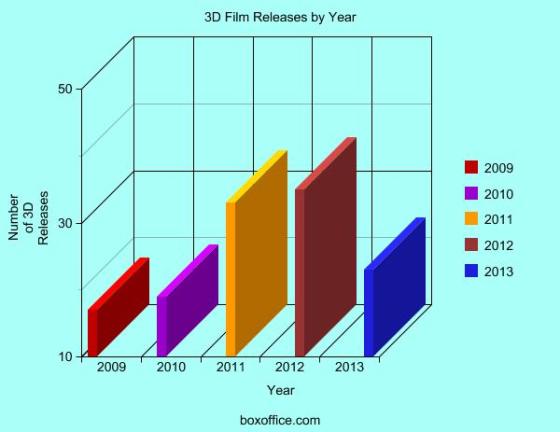By: Nicholas Renard
As the lights dim and the projector whirrs to life, the mountainous Paramount logo rushes into view. “Oohs” and “Awes” immediately emanate from the audience who adjust and readjust their plastic glasses.
We’re soon catapulted through the depths of the ocean, on a continuous heading toward a submerged, indiscernible mass. Flecks of plankton and dust float from the screen and vanish into our peripheries as the suspense heightens.
Alas, we reach our destination, the battered wreckage of the R .M.S. Titanic.
But of course it is—we’ve seen this before.
Amid increasingly frequent stereoscopic 3D major motion picture releases, “Titanic 3D” is one of many films in recent months to return to theaters for revitalized, three-dimensional screenings. Hollywood film studios, eager to capitalize from 3D cinema’s eye-popping surge in popularity, continue to commission and release 3D films at an ever-growing rate.
But despite its growing global prevalence, will 3D become the new industry standard, or are the dazzling effects and plastic glasses simply a fad?
“This is our third go-round with 3D, and what we’ve seen is story matters more than technology,” said Robert Hurst, assistant professor of film and media studies at the University of Kansas who has a Master of Fine Arts in film and video production from the University of Iowa. “I’m interested in story, not the visuals.”
Hurst added that 3D is really about getting more people to theaters however many viewers are no longer interested.
And as far as local movie theaters are concerned, 3D seems to be on the way out.
The end of an era?
“A few years ago, 3D movies came out almost every weekend, but nowadays they don’t have the allure they once did,” said Michael McMahon, a spokesperson for the Leawood, Kan. AMC Town Center 20 theater. “When ‘Avatar’ was released it set the bar very high, but (3D) isn’t doing it anymore and people leave unhappy.”
Hurst also mentioned James Cameron’s “Avatar,” in which 3D effects seemed appropriate.
That film, released in 2009 in 3D and IMAX 3D, became the first 3D film to reach $1 billion worldwide, and went on to become the highest-grossing film in history, according to Box Office Mojo. Its 3D visual effects were also applauded by most critics, including Roger Ebert of The Chicago Sun-Times.
Three years later, with the rerelease of his 1997 epic romance, “Titanic 3D,” Cameron has yet again dominated the box office, with domestic grosses more than $17 million opening weekend and more than $54 million as of April 25, according to Box Office Mojo.
But despite “Titanic 3D’s” resounding splash, local theaters say profits remain mostly unchanged.
Higher prices, similar profits.
“It’s all about the same, honestly,” said Jon Kelly, the house manager of Hollywood South Wind 12 theater in Lawrence, Kan., who declined to release box-office financial statistics. “As long as most of the (3D) glasses are returned things stay pretty even,” said Kelly, adding that 3D sales help bolster any losses in 2D ticket sales.
Kelly said 3D ticket costs, a $3 addition to any normal ticket price, are allocated directly toward the theater’s five 3D projectors on lease from the Sony Corporation.
He added that some movie-goers complain about the higher ticket costs, which he said probably won’t disappear in the near future.
And given recent announcements by some film industry magnates, neither will 3D.
Industry looks ahead.
After the recent success of his first 3D film, “Hugo,” Academy Award-winning director Martin Scorsese announced in a Guardian article that he will never work without the format again. He also addressed the need to further improve the 3D technology, which has drawn criticism regarding darkened visuals.
Scorsese is among the many proponents of future, laser-illuminated projection technology aimed at brightening 3D visuals, which could be used in theaters by the end of 2013, the article said.
With more than 20 3D films yet to release this year and at least another eight already slated for 2013, the format continues to appear unfazed. And with upcoming big-name 3D releases like “The Avengers” and “The Hobbit,” 2012 could be the biggest year for 3D yet.
“I think ‘The Avengers’ will be our most successful film of the year,” said McMahon of AMC Town Center 20. “We’re also screening every previous Avenger movie during the day leading up to the midnight premiere, which we hope will attract a huge crowd.”
CLICK TO HEAR KU STUDENTS’ OPINIONS OF 3D SUSTAINABILITY
